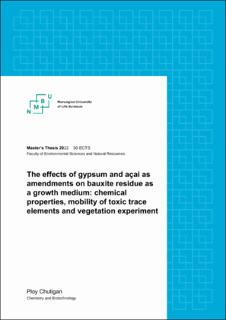| dc.description.abstract | As the third most common element in the earth's crust, aluminum possesses functional qualities for a variety of industrial and household applications. The extraction of primary aluminum from bauxite ore accelerated in response to higher demand, resulting in significant increase in bauxite residue. This by-product has unique features resulting from the diverse ore compositions and additives employed in the Bayer manufacturing process. With features such as high pH, high salt content, and the presence of toxic trace elements, the environment is significantly challenged by discharges in addition to rehabilitation and exploitation of disposal areas.
In this thesis, the effect of adding gypsum and açai both individually and in combination to improve the bauxite residue into a functioning growth medium is investigated. Bauxite residue that has been treated in the field is examined for changes in pH, electrical conductivity, organic carbon content, as well as toxic trace elements (arsenic, vanadium, and aluminum) in the porewater before, during, and after vegetation experiment with ryegrass (Lolium perenne). Simultaneously, the uptake of toxic trace elements in the vegetation is analyzed.
The results were calculated using the mean values of triplicates for each amendment. The addition of 10% açai alone lowered the pH from ~10 to ~9, whereas the addition of gypsum alone or in combination with açai significantly lowered the pH to ~7-8, which provided a favorable environment for plant growth. The amendment with 10% açai + 10% gypsum showed the best growth measured in height. The results also showed that a combination of gypsum and açai together led to better growth than either component alone. Trace element concentrations in porewater were dominated by pH, indicating degrees of leaching from solid phase to solution. Trace elements in porewater samples with higher pH in oxidizing conditions were present in anionic form and exhibited higher concentrations. The best-growing samples did not demonstrate a higher uptake of trace elements, but they were likely bound to the DOC present in the solution.
Comparisons between the amendments revealed that açai alone was insufficient to enhance the bauxite residue conditions. The lack of plant-available nutrients and organic carbon in gypsum-only amendments also inhibited plant development, but proved that gypsum is an effective approach for forming a pH-appropriate basis. Amendments with gypsum and 10% açai required no more than 10% gypsum since the system presumably reached saturation and did not increase cation exchange between Ca and Na. For future studies, it may be advantageous to experiment with additive concentrations to obtain optimal plant development and perform geochemical modeling to determine metal speciation and mobility to substantiate the findings. In addition, a larger-scale experiment with seeding in the field and an evaluation of microbiological activity may be valuable to assess the long-term effect. | |
